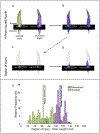Relationships between quantitative magnetic resonance imaging measures at the time of return to sport and clinical outcomes following acute hamstring strain injury
- PMID: 39032225
- PMCID: PMC11330723
- DOI: 10.1016/j.jbiomech.2024.112228
Relationships between quantitative magnetic resonance imaging measures at the time of return to sport and clinical outcomes following acute hamstring strain injury
Abstract
Hamstring strain injuries (HSI) are a common occurrence in athletics and complicated by high rates of reinjury. Evidence of remaining injury observed on magnetic resonance imaging (MRI) at the time of return to sport (RTS) may be associated with strength deficits and prognostic for reinjury, however, conventional imaging has failed to establish a relationship. Quantitative measure of muscle microstructure using diffusion tensor imaging (DTI) may hold potential for assessing a possible association between injury-related structural changes and clinical outcomes. The purpose of this study was to determine the association of RTS MRI-based quantitative measures, such as edema volume, muscle volume, and DTI metrics, with clinical outcomes (i.e., strength and reinjury) following HSI. Spearman's correlations and Firth logistic regressions were used to determine relationships in between-limb imaging measures and between-limb eccentric strength and reinjury status, respectively. Twenty injuries were observed, with four reinjuries. At the time of RTS, between-limb differences in eccentric hamstring strength were significantly associated with principal effective diffusivity eigenvalue λ1 (r = -0.64, p = 0.003) and marginally associated with mean diffusivity (r = -0.46, p = 0.056). Significant relationships between other MRI-based measures of morphology and eccentric strength were not detected, as well as between any MRI-based measure and reinjury status. In conclusion, this preliminary evidence indicates DTI may track differences in hamstring muscle microstructure, not captured by conventional imaging at the whole muscle level, that relate to eccentric strength.
Keywords: Diffusion Tensor Imaging; Hamstring Strain Injury; Reinjury; Return to Sport; Skeletal Muscle.
Copyright © 2024 Elsevier Ltd. All rights reserved.
Conflict of interest statement
Declaration of competing interest The authors declare the following financial interests/personal relationships which may be considered as potential competing interests: Select authors of this manuscript declare relationships with the following companies: Dr. Bryan Heiderscheit declares a potential conflict of interest directly related to this work (research support to institution from NBA and GE HealthCare). The other authors (CMW, SAH, MRJ, KL, RK) of this manuscript declare no direct relationships with any companies, whose products or services may be related to the subject matter of the article].
Figures






References
-
- Andersson JL, Skare S, Ashburner J, 2003. How to correct susceptibility distortions in spin-echo echo-planar images: application to diffusion tensor imaging. Neuroimage 20, 870–888. - PubMed
-
- Bayer ML, Hoegberget-Kalisz M, Jensen MH, Olesen JL, Svensson RB, Couppe C, Boesen M, Nybing JD, Kurt EY, Magnusson SP, Kjaer M, 2018. Role of tissue perfusion, muscle strength recovery, and pain in rehabilitation after acute muscle strain injury: A randomized controlled trial comparing early and delayed rehabilitation. Scand J Med Sci Sports 28, 2579–2591. - PubMed
MeSH terms
Grants and funding
LinkOut - more resources
Full Text Sources
Medical

